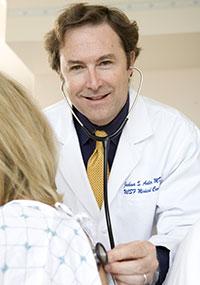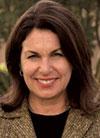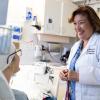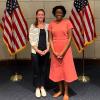
Despite Legislative Disappointment, UC Health Seeks to Optimize Use of NPs
In August 2013, after nearly a year of impassioned, sometimes bitter debate, the California State Legislature chose not to advance SB 491, a bill proposed by Democratic state Sen. Ed Hernandez that would have allowed nurse practitioners to operate without physician supervision in California.
The bill’s withdrawal disappointed many in the state, including leaders of UC Health, the state’s fourth-largest health care delivery system. UC Health does not take many political stands, but in May, in a letter to Democratic state Sen. Kevin de León, chair of the Senate Appropriations Committee, John Stobo, UC Health’s senior vice president for health sciences and services, wrote: “Enabling nurse practitioners to work and practice to the full extent of their education and training is an appropriate and available strategy that will help address the primary care physician shortage and expand access to care for many Californians.”
UC Health’s concerns about the physician shortage are heightened by the widespread belief that full implementation of the Affordable Care Act in 2014 will severely exacerbate the problem, given the expected 1.7 to 3 million Californians who will become eligible for health benefits under the ACA. According to an August article in California Healthline, only 16 of the state’s 58 counties have the supply of physicians that the federal government recommends.
“We’re barely meeting the demand now, and we have a huge distribution problem, with far too few providers in rural areas, inner cities and communities of color,” Hernandez told Science of Caring in March 2013.
Nevertheless, fierce opposition from the California Medical Association, which according to the Los Angeles Times had spent nearly $1.2 million lobbying the legislature in just the first half of 2013, was too much to overcome. Even before the bill’s withdrawal, concessions on its language had caused groups such as the American Association of Nurse Practitioners and AARP to rescind their support.
While some write off the bill’s failure to turf wars and hardball politics, it seems likely that to win this battle, those who support expanded scope must convincingly answer three questions that the CMA and others have raised about how best to fill the primary care gap:
1. Is independent NP practice safe for patients?
2. How does independent NP practice increase access for the underserved?
3. And will independent practice disrupt movement towards team-based care, which most experts believe is an essential component of modern care delivery?
Is It Safe?
The CMA and its allies say that if NPs practice independently, they will endanger patients.
But in his letter supporting SB 491, UC Health’s Stobo wrote: “The Institute of Medicine’s 2010 report entitled The Future of Nursing: Leading Change, Advancing Health and other systematic reviews of the research provide compelling evidence that advanced practice nurses are educated, prepared and qualified to provide high quality patient care in a manner that meets professional standards.”
Other organizations, generally perceived to be unbiased – including the National Governors Association and the Kaiser Commission on Medicaid and the Uninsured, the largest operating program of the Kaiser Family Foundation – have looked at the studies and come to the same conclusion. In a report published in March 2011, the Kaiser Commission on Medicaid and the Uninsured wrote: “A substantial body of research examining the quality of NP…primary care shows that these clinicians perform as well as physicians on important clinical outcome measures, such as mortality, improvement in pathological condition, reduction of symptoms, health status, and functional status.… Numerous studies show that patients are generally more satisfied with primary care provided by NPs compared to physician-provided care, and more likely to have been given appropriate advice.… Studies from England and Canada indicate the ability of non-physician clinicians to increase service capacity without any loss in the quality of clinical care.”
Joanne Spetz – who serves as associate director for research strategy at the UC San Francisco Center for the Health Professions and director of the UCSF Health Workforce Research Center – says, “There is absolutely no evidence to support the CMA position that primary care is too complex for NPs’ training.” At present, 17 states and the District of Columbia allow NPs to practice without physician oversight; others are more restrictive to varying degrees.
Even the Physicians Foundation, a group opposed to NPs practicing independently – which argues that the existing research is flawed, incomplete and not easy to generalize beyond the specifics of each study – acknowledged in a November 2012 report that there is a “lack of evidence that physicians provide higher quality care than non-physician providers. A number of the state medical society executives we spoke with expressed concern that they had very little hard data and few, if any, empirical studies with which to refute the growing body of research presented by non-physicians and their advocates – research that tends to show that their clinical outcomes are at least as good as those of physicians.”
To counter these studies, the CMA and its allies tend to point to disparities in training hours and content – and to anecdotal or hypothetical examples that illustrate where the disparities could play themselves out in ways that endanger patients.
CMA spokeswoman Molly Weedn says the CMA respects NPs’ important role in delivering integrated care, but worries that the wide gap in training hours – newly minted physicians get 24,000 hours of medical school and residency as opposed to about 4,000 hours of education for NPs – could ultimately hurt patients, if NPs were to practice without physician supervision.
Physician Elisabeth Wilson, who is the director of education in the UCSF Department of Family and Community Medicine – and who also co-teaches a course for nurse practitioner students and works alongside NPs in clinical practice at San Francisco General Hospital – says the compressed training of NPs is something to consider, but it does not disqualify them from independent practice.
"The NP students cover an enormous amount of materials in a very compressed period of time, and the temptation is to just memorize how to do something and be done with it," she says. "This is not very different from medical students, but clinical decisions emerge from knowing how to think critically about each situation, and the [physician trainees] have more time to learn that in residency," she says. "[With this in mind], if an NP is a brand-new grad, I would hope they have some form of structured support - someone with experience to help them, whether it's an MD or another, more experienced NP - but I would also hope the same for someone who just finished residency... When I think about NPs practicing independently, I have no problems with that."
“Would I argue a fresh-out-of-school NP is as good as someone who just completed a family medicine residency? Maybe not,” says Spetz. “But there are those who argue that some of medical school is wasted time for those entering primary care. And it’s also fair to point out that an NP with a few years of work experience in a primary care setting probably has equivalent skills to a physician straight out of residency.”
She adds – as do many NP supporters – that requiring residencies for NPs might be a perfectly reasonable response to concerns about training. “But to say an NP with 20 years’ experience still needs to be subordinate to someone straight out of a residency seems absurd.”
Physician John Heydt is senior associate dean of clinical affairs at UC Riverside. Formerly, he was president and CEO of University Physicians & Surgeons and senior associate dean of clinical affairs at UC Irvine’s School of Medicine, where he “tweaked” the physicians group’s bylaws to allow NPs to be part of it so, in theory, they could develop their own compensation plan and be recognized by insurance companies. “I’ve always believed everyone ought to practice at the top of their scope,” he says.
Heydt’s first boards were in family medicine, and before moving to UC, he oversaw two nurse practitioner-run federally qualified health centers. While he does not dismiss the importance of a medical education, he argues, “You’re either competent or you’re not competent. I’ve been out of residency since 1990 and I’ve never met a bad NP. They dot the i’s and cross the t’s.… When NPs showed me what they do on a pediatric visit, it’s more than what I would have done, and that’s what I’ve seen over and over, no matter the specialty.”
But what about the complex cases where training does matter? What happens, asks the CMA’s Weedn, when a patient comes in with a funny freckle on his or her hand – a potential melanoma?
“An NP might refer to a dermatologist to get this checked out, but that could take six weeks, and in the meantime, the freckle could grow and become more serious,” says Weedn. “A physician is trained to see abnormalities like that and get the patient immediately downstairs for testing. NPs aren’t trained in that way. It doesn’t mean they’re not the utmost professionals, but they do different jobs.… Having that physician supervision – with established protocols and guidelines and a physician to provide a teaching role – only increases safety.”
“Complex cases are why we have relationships with collaborating physicians,” counters Gerri Collins-Bride, director of a UCSF nurse-managed practice for mentally ill adults. “If we see something worrisome, we don’t wait; we maximize the use of clinical experts, which by the way might be an NP with a lot of dermatology experience, not just a physician.”
Wilson notes that in her clinical practice at San Francisco General’s Family Health Center, NPs consult with her frequently – and she with them. Wilson realizes that sometimes the NPs consult with her because she is a physician, but she says it’s a rare case where she actually has more clinical knowledge than an experienced NP.
Is Independent Practice Important for Meeting the Needs of the Underserved?
Even if the patient safety question is resolved to everyone’s satisfaction, the CMA is among those who have asked whether independent practice for NPs really could make a significant dent in the state’s primary care physician shortage, especially among the underserved.
It’s a question that is close to the heart of UC Health. Given its large percentage of patients on either Medicare or Medi-Cal, the UC system views itself as “part of the backbone of the safety net,” according to Terry Leach, who directs UC Health’s Center for Health Quality and Innovation.
UC Health’s support of SB 491 indicates clearly that the organization believes NPs could help meet the needs of the underserved, as do many NP groups and supporters. And there is some evidence to back these claims.
The report of the Kaiser Commission on Medicaid and the Uninsured cited an unpublished 2010 analysis by the Robert Wood Johnson Foundation that found: “NPs, and to a lesser extent, PAs [physician assistants], tend to make up a greater share of the primary care workforce in less densely populated, less urban, and lower income areas, as well as health professional shortage areas.”
The CMA, however, argues that economic factors drive NPs to practice in the same patterns as their physician colleagues – and so are no more likely to practice in underserved areas or with underserved populations.
In addition, CMA President Paul Phinney told public radio station KPCC in Los Angeles, “The argument that granting nurses independent practice will dramatically and quickly increase access is false because they’re not sitting on the sidelines now.” He says most NPs already have full patient loads.
Dean David Vlahov of UC San Francisco School of Nursing agrees that primary care clinicians already have full loads. But, he says, the demand for primary care will only increase with implementation of the Affordable Care Act, when more patients, especially healthy ones, are enrolled.
“As important, there is enormous societal pressure to control costs,” he adds. “NPs are trained in a shorter amount of time and for less cost, with less student debt. The shorter training time is partly because clinical training actually begins with nurses’ undergraduate curriculum – and students in graduate programs enroll straight into one of several specialties, including primary care. We believe independent practice will draw more NP students and, so, more quickly address the need for competent new clinicians while creating new opportunities for more experienced NPs to meet the needs of the underserved.”
Another argument some physician groups advance is that NPs are beginning to specialize in much the same way as their physician colleagues. An August 15 report in American Family Physician documented this phenomenon and said it indicates NPs aren’t a viable solution to the primary care crisis.
“I don’t believe it,” says Patricia Dennehy, of the report. Dennehy directs the UCSF nurse-managed health clinic at Glide Health Services in San Francisco’s Tenderloin District. “Primary care is bread and butter for NPs. The building of long-term relationships – the partnership between provider and recipients of care – it’s exactly what nursing does, and if we expand residency programs in primary care, that will draw quite a number to the field.”
Vlahov acknowledges that there is a huge demand for NPs trained in specialty areas to practice in tertiary care hospitals, and many experienced acute care NPs become valuable teachers of the medical students and new residents to whom they eventually report. But, he notes, “Using this point about specialty training as a concern to rationalize restriction of primary care NP practice, especially in underserved populations, just doesn’t follow. The point we should be talking about is how to increase the number of primary care clinicians who can provide care to the level of their education and experience.”
Will Independent Practice Undermine Team-Based Care?
As for integrated, team-based care, nearly everyone agrees this is an essential component of the next generation of health care delivery, but there is considerable disagreement about the impact of independent NP practice on teams.
“A team approach is not only better from the quality standpoint – because you have more people looking at the care – but it also is more efficient,” Phinney told KPCC. “You can get more done with a team than you can with individual practitioners that are in completely separate environments.”
“And from our perspective, integrated teams are better and more efficient when led by a physician,” says the CMA’s Weedn.
NP groups counter that NP training is rooted in the team concept, including a strong emphasis on knowing when to refer to or consult with physician colleagues in much the same way that primary care physicians work with specialty colleagues. Glide’s Dennehy says she has countless examples of the way NPs maintain a team-based mentality, even in a nurse-managed clinic like the one she runs.
“We are very conscientious professionals, and we do and will consult,” says Dennehy. “At Glide, we have an excellent physician colleague, who is a great consultant when we hit that really complex case with four concurrent problems, but some of the rules are completely silly. Why should a physician have to sign my order for wheelchairs or diapers? And given the cost and efficiency challenges we all face, those rules make things so much less efficient and affordable.”
Wilson says at San Francisco General’s Family Health Center, the team approach is less hierarchical; clinical leads – one MD, one NP and one RN – share team leadership and look for ways to build on each other’s strengths. “It builds a real level of respect for what everyone brings,” says Wilson. “We try to walk the walk of everyone working to the top of their capacity.”
“From UC Health’s perspective, I think we can find ways to ensure that team-based care grows along with more independent NP practice, by creating time for huddles and consults and making sure NPs have access to consultations in the same way that primary care physicians have access to specialists,” says Leach.
Testing Expanded Roles Within the Law’s Constraints
In fact, even in the aftermath of SB 491’s withdrawal, UC Health continues to explore ways to expand the role of its NPs.
That effort gathered steam in late 2012, when in a meeting sponsored by UC Health’s Center for Health Quality and Innovation, UCSF Medical Center’s Chief Medical Officer Joshua Adler and Dean Heather Young of the Betty Irene Moore School of Nursing at UC Davis led a policy panel that gauged the interest in expanding the role of NPs and other health professionals in the UC Health system.
“With health reform improving access to care and severe downward cost pressures on delivery, we felt we needed to seriously look at and optimize the use and participation by all health professionals,” says Adler.
Working partly from a survey conducted by UC San Francisco School of Nursing’s Collins-Bride and Pilar Bernal de Pheils, the group looked at where the limitations on scope of practice existed within the UC system – and why those limitations existed.
The session helped broaden the belief at UC Health that expanded scope of practice can help reach the organization’s goal of better access and lower costs – and was likely one contributor to the decision to back SB 491.
“If the barriers were removed, and NPs could manage a patient panel as their physician colleagues do, I think this would provide a larger, well-educated workforce,” says Leach.
But in the wake of SB 491’s defeat, making change – even within a willing community like UC Health – remains a challenge. This is especially so in primary care. While there are certainly those who would like to see more independence and visibility for NPs in the hospital setting, it is primary care where the most significant barriers remain.
 UCSF Medical Center’s Chief Medical Officer Joshua Adler “I’ve had a long history at UCSF – we have spectacular NPs who are competent to provide care at a very high level independently,” says Adler. “There are a number of advantages to expanding access to primary care NPs in the UC system. One key challenge, however, is that the economics for primary care practice are difficult whether provided by NPs or physicians.”
UCSF Medical Center’s Chief Medical Officer Joshua Adler “I’ve had a long history at UCSF – we have spectacular NPs who are competent to provide care at a very high level independently,” says Adler. “There are a number of advantages to expanding access to primary care NPs in the UC system. One key challenge, however, is that the economics for primary care practice are difficult whether provided by NPs or physicians.”
Overcoming the economic barriers is at least partly dependent on data that measure NP cost-effectiveness, but that data can be hard to come by when what NPs do is often hidden because of billing practices that demand they bill under a physician’s license.
The visibility issue also makes it hard to determine how much NPs can expand access. “If NPs are not listed on websites, or with insurers, people don’t even know they can choose an NP as their primary care provider,” says Young.
“We have to find ways to make NPs more visible,” says Leach. “If we do that, we can also better measure their outcomes.… I’m very data driven, and if I’m looking at data that asserts patients and populations do better with NPs, because of NP strengths like patient education, then that would make a real difference.”
Unfortunately, better clinical outcomes won’t always have a positive effect on costs and efficiency, Leach warns. “If NPs, under current law, have to run things by a supervising physician, even a simple order like ordering home care, that’s just not as efficient,” she says. “Also, a typical primary care physician doesn’t work an eight-hour day. If an NP is a covered union employee and we have to start paying overtime, I am told that it’s possible that compensation for the NP will not be as cost-effective. These are real barriers.”
Nevertheless, UC Health may not have time to resolve all of these problems before responding to the capacity demands of the Affordable Care Act; Leach is among those who believe overcoming the barriers to NP practice is one important component of building the necessary capacity.
“We need to address the pipeline,” she says. “I don’t believe physicians can or should be supplanted, but if we augment with NPs, trained in primary care – especially those who have an additional focus like diabetes, HIV, asthma – and cross-train with residents and pharmacy students, we can have a larger and complementary workforce.”
What’s Next
Even as groups throughout UC Health prepare for 2014, many have come to believe it is time to get beyond the battles over NP scope of practice.
When public media KQED’s health editor Lisa Aliferis asked Adler in early 2013 if he thought doctors were behaving ethically when they organized against allowing nurse practitioners or other non-MDs to provide expanded primary care, Adler said, “I think it’s wrong.… I think protecting patient care only within the realm of physicians is a bad strategy for the United States.”
“We’d be better off fighting tobacco use,” says Young. “This is about constantly looking for opportunities to improve what we do to give the best care possible to all people. We’ve all been guilty at times of being profession-centric, but this is now beyond what nurses or doctors need; it’s a matter of national importance to get what’s needed for our health system.”




